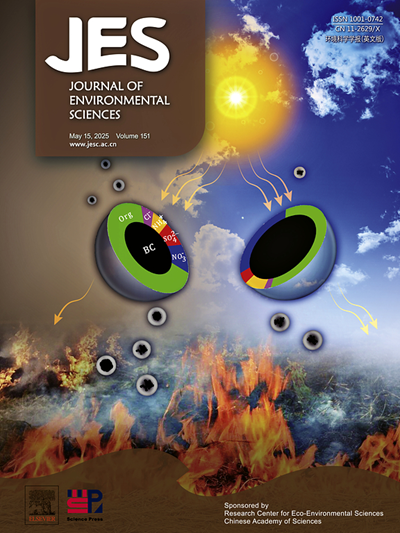水生无脊椎动物中的卤化有机污染物。鱼类食物网:全球分布和营养放大
IF 5.9
2区 环境科学与生态学
Q1 ENVIRONMENTAL SCIENCES
引用次数: 0
摘要
持久性卤化有机污染物(HOPs)因其持久性、生物蓄积性和对水生生物的潜在毒性而受到全球关注。啤酒花的营养转移可以影响其对人类和生态系统的毒性作用。以往的研究主要集中在特定区域或生态系统背景下的啤酒花生物放大效应,然而,全球不同水生系统中不同啤酒花间营养放大因子(TMFs)的变化尚不清楚。通过整理全球范围内有关多氯联苯(PCBs)、多溴联苯醚(PBDEs)或全氟烷基酸(PFAAs)沿无脊椎动物-鱼类食物网的TMFs的文献,我们的分析显示,亚洲、北美和欧洲的酒花酒花污染水平最高。多氯联苯的营养放大能力最高(TMF = 3.14),其次是多溴二苯醚(TMF = 2.48)和PFAAs (TMF = 1.97)。PCB、PBDE和PFAA的TMF值和TMF超过1的概率与卤化度和碳链长度呈抛物线关系。具体而言,含6个氯的多氯联苯、含5个溴的多溴联苯和含12个碳的PFAAs在食物网中表现出最大的营养转移能力和潜力。多氯联苯(PCBs)和PFAAs的分异表现为:随着营养水平的提高,氯化程度越高、链越长的PFAAs所占比例越高,而其他PFAAs所占比例越低。令人惊讶的是,我们还发现站点纬度与HOP同系物的TMF值呈正相关。本研究为评价啤酒花的生态和健康风险提供了有价值的依据,有助于制定健全的水生环境管理标准。本文章由计算机程序翻译,如有差异,请以英文原文为准。

Halogenated organic pollutants in aquatic invertebrate – Fish food webs: Global distributions and trophic magnification
Persistent halogenated organic pollutants (HOPs) are globally concerned owing to their persistence, bioaccumulation, and potential toxicity to aquatic organisms. The trophic transfer of HOPs can affect their toxic effects on both humans and ecosystems. Previous studies mostly focused on HOPs biomagnification within specific regional or ecosystem contexts, however, the variation in trophic magnification factors (TMFs) among different HOPs across a spectrum of diverse aquatic systems globally remains unclear. By collating literatures encompassing TMFs of polychlorinated biphenyls (PCBs), polybrominated diphenyl ethers (PBDEs), or perfluoroalkyl acids (PFAAs) along invertebrate–fish food webs on a global scale, our analysis revealed that Asia, North America, and Europe exhibited the highest pollution levels of HOPs. PCBs were found to have the highest trophic magnification capability (TMF = 3.14), followed by PBDEs (TMF = 2.48) and PFAAs (TMF = 1.97). TMF values and the probability of TMF exceeding 1 for PCB, PBDE and PFAA congeners showed a parabolic relationship with halogenation degree and carbon chain length. Specifically, PCBs with 6 chlorines, PBDEs with 5 bromines, and PFAAs with 12 carbons exhibited maximum trophic transfer capability and potential along food webs. Fractionation of PCBs and PFAAs was observed, with the proportions of higher chlorination degree and longer chain PFAAs increasing while the others decreased with trophic levels. Surprisingly, we also found a positive relationship between site latitude and TMF values of HOP congeners. This study provides a valuable basis for gauging ecological and health risks of HOPs, facilitating the development of robust standards for aquatic environment management.
求助全文
通过发布文献求助,成功后即可免费获取论文全文。
去求助
来源期刊

Journal of Environmental Sciences-china
环境科学-环境科学
CiteScore
13.70
自引率
0.00%
发文量
6354
审稿时长
2.6 months
期刊介绍:
The Journal of Environmental Sciences is an international journal started in 1989. The journal is devoted to publish original, peer-reviewed research papers on main aspects of environmental sciences, such as environmental chemistry, environmental biology, ecology, geosciences and environmental physics. Appropriate subjects include basic and applied research on atmospheric, terrestrial and aquatic environments, pollution control and abatement technology, conservation of natural resources, environmental health and toxicology. Announcements of international environmental science meetings and other recent information are also included.
 求助内容:
求助内容: 应助结果提醒方式:
应助结果提醒方式:


